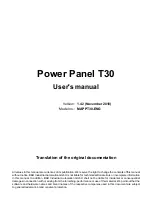
Medium Voltage ZnO Surge Arresters
2005-06-Arrester installation instr-CIS-Rev 1
2
Strictly follow the local safety instructions and
maintenance procedures.
Select a mounting position as close as
practicable to the equipment (transformer, cable
termination, ...) to be protect in order to obtain
the highest degree of protection.
Connect the ground lead to the arrester ground
terminal stud or accessory. Fasten the nut to the
torque indicated in the relevant drawing.
In case the arrester comes with a metallic
bracket attached it is possible to connect the
ground lead to the bracket. The line lead may
also be left out if the bracket or the arrester
terminal is directly mounted on the earthed tank
or frame of the apparatus provided that the
electrical contact is reliable and earthing
interconnections are suitable. In doubt please
use separate conductor cables or strip to
connect the bracket or the arrester terminal to
system earth.
Connect the line lead to the arrester line terminal
stud or accessory. Fasten the nut to the torque
indicated in the relevant drawing.
Make the arrester ground and line connections
as short as possible avoiding sharp bends and
loops. If the line connection cannot be made
short, consider connecting the line directly to the
arrester and continue from there.
The continuous mechanical stress applied to the
arrester i.e. via the connection shall not exceed
the specified values. Mechanical overload may
shorten
the
arrester’s
service
lifetime
significantly.
In case the arrester is equipped with a
disconnector device (a „D“ is shown in the middle of
the description, e.g. ARR-ACC-B
D
M. ) make sure that
the ground lead is flexible enough to allow the
disconnector to operate properly.
Re-energize the electrical system. Avoid single-
phase switching because this may lead to ferro-
resonance of the transformer! If single-phase
switching needs to be done, make sure that you
are operating with protection as arresters may be
destroyed in case of ferro-resonances.
Maintenance
Bowthorpe
arresters are maintenance free. There
are no serviceable parts inside.
Performance checks are not required during the
expected service life.
Removing Arresters
The polymeric housing of failed surge
arrester sometimes is inflated. This can happen if
the fault current is switched off fast before the
housing ruptures!
This typically does not represent a hazard if the arrester
is allowed to cool down to ambient temperature. Be
careful anyway when removing such kind of arresters.
Make sure that the electrical system is de-
energized.
Strictly follow the local safety instructions and
maintenance procedures.
Disconnect the line lead from the circuit.
þ
Disconnect the ground lead from the circuit.
Clearances
a
b
a
System Voltage
U
m
[kV]
ph/ph
*
(a)
[mm]
ph/ground
*
(b)
[mm]
7,2
152
121
12
182
151
17,5
222
191
24
282
251
36
382
351
*
local regulations and standards may require
wider clearances!
Table 1: Minimum clearances following IEC60071-2
for altitudes up to 1000 m (3300 ft).
!






















